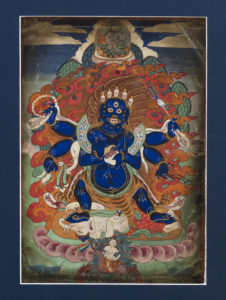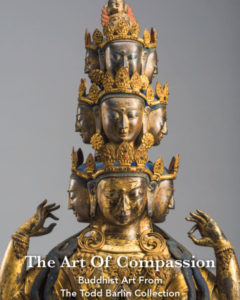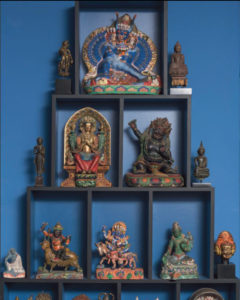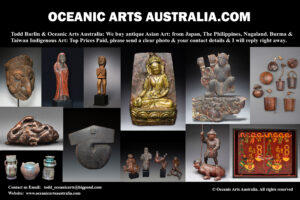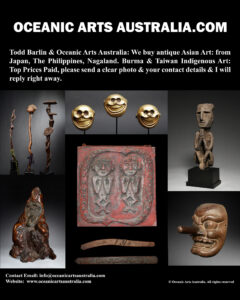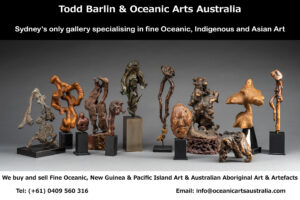A Superb Old Mongolian Buddhist Thangka Painting of Blue Mahakala
| Collection No. | TB-2692 |
|---|---|
| Size | 26cm x 18cm |
See more Fine Tsakli Painting in Tsakli Painting Gallery
A Superb Old Mongolian Buddhist Thangka Painting of Blue Mahakala from the 19th Century
Finely painted with polychrome pigments on handmade cloth. Dating from the late 19th Century & with some minor loss to the paint as clearly seen in the photograph top right & left corners. The main figure of Mahakala is in very good condition.
Mahakala is a Protector Deity or Dharmapala and specifically the primary Wisdom Protector of Himalayan and Tibetan & Mongolian Buddhism. Mahakala, in all his forms, is one of the most popular, protective deities in Mongolia and his practice transcends all Buddhist traditions. This six-armed form of Mahakala stands dressed in the appropriate terrifying ornaments of a protector. Some of these are a tiger skin (just visible between his legs and on his right thigh), snake garlands, and a skull crown. He is surrounded by whirling flames, which symbolize the end of a world age. He holds in his right arm a skull rosary, a yogic skull drum with silk tassels, and a chopper held to the front. In his left arm, he holds a trident, a lasso with a metal hook, and, to the front, a skull cup of wisdom. He stands on top of an elephant, which represents all obstacles to Buddhist practice.
Buddhist teaching is not something learned from books, although they certainly play a part in reinforcing what one has already learned. The prime way of learning in Tibeto-Mongol Buddhism is through one’s master’s words. A common sentiment in those lands is that, without a fully qualified master to transmit them, the Buddha’s teachings may well never have existed.
In learning the many complex rituals involving sometimes hundreds of deity forms, their names, iconography, secret syllables, and so on, a student must have a teacher who almost always transmits this information orally. As an aid to memory, especially where complex deities are to be learned, small cards representing these myriad forms are shown by the master to the teacher, and the details, often found on the back of each card, are read aloud by the teacher with the intention that the student retains the details in their memory.
When a deity form has been fixed in the mind and one has embarked on the path of Buddhist tantra, at a certain stage one is expected to select a tutelary deity; that is, a deity that is core to one’s heart practice. This deity then becomes the focus of one being, and it is not unusual for both monks and laypeople to spend a great deal of money commissioning a large painting of such deities. These scroll paintings are known as thangkas, this one used by travelers in a shrine.
Provenance: The Todd Barlin Collection of Tibetan and Mongolian Buddhist Art & Asian Art
Exhibited and Published: The Art of Compassion: Buddhist Art from The Todd Barlin Collection. Sydney Australia 2018. Catalogue written By David Templeman, Page 35
INQUIRE HERE
To see many more rare items and the finest masterpieces, please make an appointment with us to visit the gallery.
For all inquiries, please contact us.

